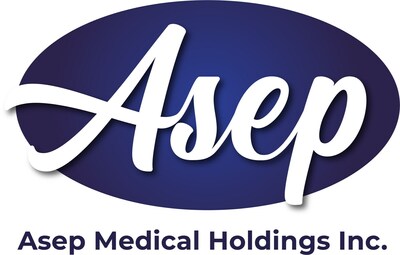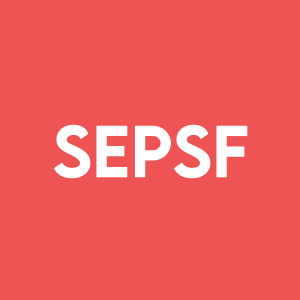Asep Medical Confirms the Use of AI - Enables Improved Treatments for Common Biofilm Infections and Rapid Sepsis Diagnostics
Biofilms are communities of bacteria that infect surfaces and cause
Another use for AI technology (LASSO regression) is in the development of the SepsetER blood-based gene expression test that is preparing to enter 510(k) regulatory approval studies in the
"We have harnessed AI to diagnose sepsis. Sepsis is a severe disease responsible for one in five deaths worldwide1 and essentially all deaths from pandemic microbes like COVID-19," says Dr. Hancock, Chair and CEO of Asep Inc. "It is critical to identify sepsis as early as possible due to the
AI was also used to simplify the extreme complexity7 of sepsis, which has limited treatments to date. In clinical studies of patients from 4 countries/4 continents published by the Lancet Journal EBioMedicine8 and the Nature Journal Scientific Reports9, LASSO regression AI methods were applied. Five groupings (endotypes) of patients were identified as showing major differences in the underlying immune defects in each group8. These endotypes could be assessed using simple gene assays that were 89
The failure of antibiotics11 due to delayed diagnosis of sepsis, the high prevalence of recalcitrant biofilm infections and increased antibiotic resistance, compounded by declining antibiotic discovery, are among society's most pressing health issues. As described above, Dr. Hancock and his team have applied AI to discover a host of antimicrobial peptides (strings of a dozen or so amino acids), representing a promising new class of antibiotics. Asep Inc. has adapted these AI methods to address antibiotic failure associated with biofilms (a multi-cellular growth state of bacteria adaptively resistant to conventional antibiotics)12,13. Dr. Hancock's team used peptide array technology to prepare large random peptide libraries created using the amino acid composition of the most active peptides. The resultant data was used with an AI technique called artificial neural networks to develop quantitative in-silico models of antibiotic activity2,12. Random tests proved remarkably effective in predicting the activity of 100,000 virtual peptides. The best peptides, representing the top quartile of predicted activities, were effective against a broad array of multidrug-resistant "Superbugs" with activities that were equal to or better than four highly used conventional antibiotics, more effective than the most advanced clinical candidate antimicrobial peptide, and protective against Staphylococcus aureus infections in animal models. Similar methods were used to derive excellent antibiofilm peptides. Asep is preparing to take the best of these peptides to the clinic.
"We use AI daily as a valuable tool in the battle against antibiotic failure to solve problems that have defied conventional methods. While others are trying to figure out how AI can be best used, we are already using it with amazing success in diagnostics and therapeutics. Asep Inc. is dedicated to leveraging AI's power to improve human health," said Dr. Evan Haney, Chief Scientific Officer of Asep.
Asep Medical Holdings Inc. (asepmedical.com) is dedicated to addressing the global issue of antibiotic failure by developing novel solutions for significant unmet medical needs in human medicine. The Company is a consolidation of three existing private companies, all with technology in advanced development — Sepset Biosciences Inc. (proprietary diagnostic tools to enable the early and timely identification of sepsis), ABT Innovations Inc. (broad-spectrum therapeutic agents to address multi-drug resistant biofilm infections), and SafeCoat Medical Inc. (an antimicrobial peptide, anti-fouling medical device coating technology).
Sepset Biosciences Inc. (sepset.ca) is developing a diagnostic technology that involves a patient gene expression signature that predicts the development of severe sepsis, one of the significant diseases leading to antibiotic failure, since antibiotics are the primary treatment for sepsis. Sepsis was responsible for nearly
ABT Innovations Inc.'s (abtinnovations.ca) peptide technology covers a broad range of therapeutic applications, including bacterial biofilm infections (medical device infections, chronic infections, lung, bladder, wound, dental, skin, ear-nose and throat, sinusitis, orthopaedic, etc.), anti-inflammatories, anti-infective immune-modulators and vaccine adjuvants. The company is in the pre-clinical development phase with promising data.
SafeCoat Medical Inc.'s (safecoatmedical.com) technology incorporates self-assembling biocompatible polymers that can be combined with conjugated antimicrobial peptides and applied to virtually any surface as stable antimicrobial and/or anti-fouling coatings. Of particular interest is the application of this versatile antimicrobial coating to various medical devices and implants that often become contaminated with biofilm infections. SafeCoat is optimizing methods to manufacture and apply these anti-bacterial coatings to a host of surfaces and can tailor the composition of the coating and associated peptide sequences for any desired application.
This news release contains certain "forward-looking statements" within the meaning of such statements under applicable securities law. Forward-looking statements are frequently characterized by words such as "anticipates," "plan," "continue," "expect," "project," "intend," "believe," "anticipate," "estimate," "may," "will," "potential," "proposed," "positioned" and other similar words, or statements that certain events or conditions "may" or "will" occur. These statements include but are not limited to the successful clinical testing of our Sepsis diagnostic test and its intended filing for regulatory approval; the Company not receiving regulatory approval as planned or at all; the undertaking of pre-clinical studies on our lead therapeutic, with the expectation that this will lead to fast-track clinical trials; the timeframe for diagnosis of sepsis with the company's products; the potential opportunities for the generation of revenue; the therapeutic benefits of the company's products; and other statements regarding the company's proposed business plans. Various assumptions were used in drawing conclusions or making the predictions contained in the forward-looking statements throughout this news release. Forward-looking statements are based on the opinions and estimates of management at the date the statements are made and are subject to a variety of risks including the risk that the company's products may not perform as expected; that the company may not receive the requisite regulatory approvals or results of testing; the Company's testing of the products may not be successful and approvals may not be obtained in the estimated timelines or at all; the company may not be able to generate revenue from its products as expected or at all; the market for the company's products may not be as described in this news release; and various other risk factors identified in the Asep Medical Inc.'s prospectus dated November 9, 2021, and in the company's management discussion and analysis, available for review under the Company's profile at www.sedar.com and uncertainties and other factors that could cause actual events or results to differ materially from those projected in the forward-looking statements. Asep Medical Inc. is under no obligation and expressly disclaims any intention or obligation to update or revise any forward-looking statements, whether as a result of new information, future events or otherwise, except as expressly required by applicable law.
ENDNOTES
2 Haney, E.F., Y. Brito-Sánchez, M.J. Trimble, S.C. Mansour, A. Cherkasov, and R.E.W. Hancock. 2018. Computer-aided discovery of peptides that specifically attack bacterial biofilms. Sci. Reports 8:1871. |
3 Cámara et al. (2022) npj Biofilms and Microbiomes. 8:42. |
4 Hu, J., J. Yu, H. Liu, Z. Wang, M. Haapasalo, E.F. Haney, R.E.W. Hancock, S. Deng, and Y. Shen. 2023. Dynamic killing effectiveness of mouth rinses and a d-enantiomeric peptide on oral multispecies biofilms grown on dental restorative material surfaces. J. Dentistry. 134:104552. |
5 Wu, B.C., E.F. Haney, N. Akhoundsadegh, D. Pletzer, M.J. Trimble, A.E. Adriaans, P.H. Nibbering and R.E.W. Hancock. 2021. Human organoid biofilm model for assessing antibiofilm activity of novel agents. NPJ Biofilms and Microbiomes 7:8. |
6 Alford, M.A., K.-Y.G. Choi, M.J. Trimble, H. Masoudi, P. Kalsi, D. Pletzer, R.E.W. Hancock. 2021. Murine models of sinusitis infection for screening antimicrobial and immunomodulatory therapies. Frontiers Cell. Infect. Microbiol. 11:621081. |
7 Rudd, K. E. et al. Global, regional, and national sepsis incidence and mortality, 1990-2017: analysis for the Global Burden of Disease Study. Lancet 395, 200–211 (2020). |
10 Kumar, A. et al. Duration of hypotension before initiation of effective antimicrobial therapy is the critical determinant of survival in human septic shock. Crit Care Med 34, 1589–1596 (2006). |
11 Haney, E.H., and R.E.W. Hancock. 2022. Addressing antibiotic failure – beyond genetically encoded antimicrobial resistance. Frontiers Drug Discov. 2:892975. |
12 Cherkasov, A., K. Hilpert, H. Jenssen, C.D. Fjell, M. Waldbrook, S.C. Mullaly, R. Volkmer and R.E.W. Hancock. 2009. Use of artificial intelligence in the design of small peptide antibiotics effective against a broad spectrum of highly antibiotic resistant Superbugs. ACS Chemical Biol. 4:65-74. |
13 Hancock, R.E.W., M. Alford, and E.F. Haney. 2021. Antibiofilm activity of host defence peptides: Complexity provides opportunities. Nature Microbiol. Rev. 19:786-797. |
![]() View original content to download multimedia:https://www.prnewswire.com/news-releases/asep-medical-confirms-the-use-of-ai---enables-improved-treatments-for-common-biofilm-infections-and-rapid-sepsis-diagnostics-302088727.html
View original content to download multimedia:https://www.prnewswire.com/news-releases/asep-medical-confirms-the-use-of-ai---enables-improved-treatments-for-common-biofilm-infections-and-rapid-sepsis-diagnostics-302088727.html
SOURCE ASEP Medical Holdings Inc.










